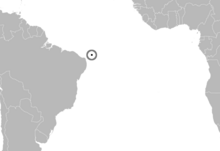| Noronha skink | |
|---|---|

| |
| Scientific classification | |
| Domain: | Eukaryota |
| Kingdom: | Animalia |
| Phylum: | Chordata |
| Class: | Reptilia |
| Order: | Squamata |
| Family: | Scincidae |
| Genus: | Trachylepis |
| Species: | T. atlantica
|
| Binomial name | |
| Trachylepis atlantica (Schmidt, 1945)
| |

| |
| Location of Fernando de Noronha, the island to which the Noronha skink is endemic.[2] | |
| Synonyms[fn 8] | |
| |
The Noronha skink[13] (Trachylepis atlantica) is a species of skink from the island of Fernando de Noronha off northeastern Brazil. It is covered with dark and light spots on the upperparts and is usually about 7 to 10 cm (3 to 4 in) in length. The tail is long and muscular, but breaks off easily. Very common throughout Fernando de Noronha, it is an opportunistic feeder, eating both insects and plant material, including nectar from the Erythrina velutina tree, as well as other material ranging from cookie crumbs to eggs of its own species. Introduced predators such as feral cats prey on it and several parasitic worms infect it.
Perhaps seen by Amerigo Vespucci in 1503, it was first formally described in 1839. Its subsequent taxonomic history has been complex, riddled with confusion with Trachylepis maculata and other species, homonyms, and other problems. The species is classified in the otherwise mostly African genus Trachylepis and is thought to have reached its island from Africa by rafting. The enigmatic Trachylepis tschudii, supposedly from Peru, may well be the same species.
- ^ Colli, G.R., Fenker, J., Tedeschi, L., Bataus, Y.S.L., Uhlig, V.M., Silveira, A.L., da Rocha, C., Nogueira, C. de C., Werneck, F., de Moura, G.J.B., Winck, G., Kiefer, M., de Freitas, M.A., Ribeiro Junior, M.A., Hoogmoed, M.S., Tinôco, M.S.T., Valadão, R., Cardoso Vieira, R., Perez Maciel, R., Gomes Faria, R., Recoder, R., Ávila, R., Torquato da Silva, S., de Barcelos Ribeiro, S. & Avila-Pires, T.C.S. 2019. Trachylepis atlantica. The IUCN Red List of Threatened Species 2019: e.T120689136A134890404. https://dx.doi.org/10.2305/IUCN.UK.2019-1.RLTS.T120689136A134890404.pt. Downloaded on 19 April 2020.
- ^ Cite error: The named reference
Rea450was invoked but never defined (see the help page). - ^ Cite error: The named reference
G289was invoked but never defined (see the help page). - ^ Mausfeld and Vrcibradic, 2002, p. 293; Bauer, 2003, p. 4
- ^ Gray, 1845, p. 111
- ^ Mausfeld and Vrcibradic, 2002, p. 293; Miralles et al., 2009, p. 57
- ^ Boulenger, 1887, p. 160
- ^ Mausfeld and Vrcibradic, 2002, pp. 292, 294
- ^ Burt and Burt, 1931, p. 302
- ^ Cite error: The named reference
S45was invoked but never defined (see the help page). - ^ Cite error: The named reference
Mea290was invoked but never defined (see the help page). - ^ Cite error: The named reference
Mea57was invoked but never defined (see the help page). - ^ Rocha et al., 2009, p. 450; Sazima et al., 2005, p. 2; Silva et al., 2005, p. 62; Sazima et al., 2005, p. 1
Cite error: There are <ref group=fn> tags on this page, but the references will not show without a {{reflist|group=fn}} template (see the help page).
